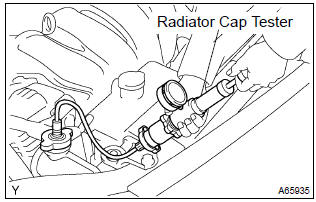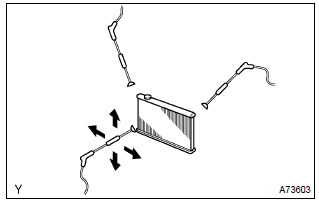Toyota Corolla (E120): On–vehicle inspection
1. Inspect cooling system for leaks

Caution
: to avoid the danger of being burned, do not remove the radiator cap while the engine and radiator are still hot, as fluid and steam can be blown out under pressure.
- fill the radiator with coolant and attach a radiator cap tester.
- warm up the engine.
- pump it to 118 kpa (1.2 Kgf/cm2, 17.1 Psi), and check that the pressure does not drop.
Hint
: if the pressure drops, check the hoses, radiator or water pump for leaks. If no external leaks are found, check the heater core, cylinder block and head.
2. Check engine coolant level at reservoir
- the engine coolant level should be between the ”low” and ”full” line.
Hint
: if low, check for leaks and add ”toyota long life coolant” or equivalent up to the ”full” line.
3. Check engine coolant quality
- remove the radiator cap.
Caution
: to avoid the danger of being burned, do not remove the radiator cap while the engine and radiator are still hot, as fluid and steam can be blown out under pressure.
- check if there is any excessive deposits of rust or scale around the radiator cap and radiator filler hole; the coolant should be free from oil.
Hint
: if excessively dirty, replace the coolant.
- reinstall the radiator cap.
4. Inspect fins blockage

- If fins are clogged, wash them with water or a steam cleaner and dry with compressed air.
Notice
:
- if the distance between the steam cleaner and core is too close, there is a possibility of damaging the fins, so keep the following injection distance.

- If the fins are bent, straighten them with a screwdriver or pliers.
- Be careful not pour water directly onto electronic components.
Other materials:
Headlight switch
The headlights can be operated
manually or automatically.
Operating instructions
Operating theswitch
turns on the lights as follows:
For the U.S.A.
The headlights, daytime
running lights and
all the lights listed below turn
on and off automatically.
The side marker,
parking,
LED ac ...
Using an anchor bracket
(for top tether strap)
(except for Puerto Rico)
■ Anchor brackets (for top
tether strap)
Anchor brackets are provided
for each rear seat.
Use anchor brackets when fixing
the top tether strap.
Anchor brackets
Top tether strap
■ Fixing the top tether strap
to the anchor bracket
Install the child restraint system
in accordance to the opera ...
Overhaul
Hint:
installation is in the reverse order of the removal. But the
installation is indicated only when it has a
point.
In the rh side, work in the same procedure as in the lh side.
1. Remove front armrest assy lh
Using a screwdriver, remove the front armrest.
Hint:
tape the ...


